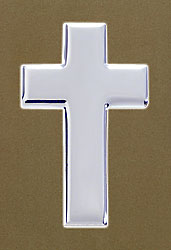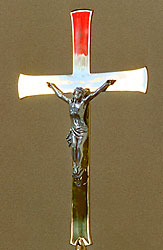 |
 |
 |
 |
Cross or Crucifix?
Theology determines preference
Sentinel Wire Services - Used by permission of
©The Holland Sentinel Online.
|
DALLAS - - There was incense and candles. There was an image of the crucified Jesus. And there was the image of Jesus taken down from the cross and wrapped in a shroud. This somber drama, known as the "un-nailing," was part of the Good Friday service at Holy Trinity Greek Orthodox Church in North Dallas. Good Friday is a day in which Christians fix their gaze most intently on the cross. Ever since Jesus' crucifixion, the cross has been the most enduring symbol of the Christian faith. It's found atop steeples, in sanctuaries and in homes. Some are plain, others are ornate, but all convey the same meaning: victory over death. "The victory of the cross comes not from Jesus' death, but from his resurrection," said the Rev. Anthony Savas, assistant priest at Holy Trinity. Catholics say they prefer crucifixes to remind them of the depth of God's love. Protestants prefer crosses without a body to emphasize the Resurrection. Orthodox have icons that depict the crucifixion but prefer plain crosses to wear as jewelry. The debate over which is better sometimes gets contentious. Historically, Christians have used each to reflect on Jesus' suffering. Catholics, in turn, point to plain crosses and accuse Protestants of wanting glory without suffering. "We're not resurrected yet, which is why the crucifix is important," said the Rev. Michael Duca, rector of Holy Trinity Catholic Seminary in Irving. The Rev. Scott Albergate thinks he may have found the middle ground. Hanging in his Episcopal church is a cross with an image of the resurrected Jesus. "His hands are raised high," said the assistant priest at St. Martin-in-the-Fields Church in Keller. "It's a symbol of victory." He said the image is a helpful teaching device. Youth often ask him the details of Jesus' crucifixion. "A bare cross just doesn't make it real to them," he said. Christians in the first three centuries used crosses for private devotions. But once Christianity was not longer a persecuted religion, the cross became its most visible symbol. The crucifix became more prominent in the fifth century. Scholars suspect that part of the delay was out of sensitivity to Christians who had had relatives executed by crucifixion. Over the centuries, artists depicted Jesus' death in countless ways. During the Middle Ages, crosses were studded with heavy jewels. Irish crosses were intricately geometrical. Baroque art showed Christ suffering his head cast back, his mouth open in agony. "When the body is on the cross, we can see and feel Jesus' suffering," said Beatriz Marcias of Dallas, who's Catholic. A new ruling from the Vatican will soon make a crucifix mandatory in every Catholic sanctuary. Until that happens, some Catholic churches are making crosses more central in worship than crucifixes. Bells dangle from the slender cross used at St. Philip the Apostle Catholic Church in Lewisville. As worship begins, the long, iron cross is placed in a prominent place. "When I hear the bells, I hear joy," said church member Linda Woosley. "We don't need corpses on all of our crosses. People forget that Jesus is alive and with us today." For years, plain wooden crosses were most popular in non-Catholic circles. But more and more, Christians are buying ornate crosses that blend in with the decor of their homes. Last year, evangelical bookstores reported a boom in crosses painted with vines and flowers. Also selling well are matted and framed images of the resurrected Jesus with an accompanying Bible verse. "It's become a decorative accessory for walls," said Jim Potts, president of Dicksons in Seymour, Ind., one of the country's largest suppliers to Christian bookstores. "People are drawn to colorful, pretty crosses." But the cross is a mixture of ugliness and beauty, representing death and life, said the Rev. Craig Lawless, assistant pastor of Lakeside Baptist Church in Dallas. "The crowning victory for Christians is the resurrection," he said. "But without the cross, there would have been no resurrection." |
Subject Gallery Subject Gallery 2 Home
| Credits: U.S. Army Chaplain's Lapel Cross, photograph by © Eric Shindelbower. This cross was given to me by Chaplain (LTC) Robert M. Santry, Aviation Center Chaplain, U.S. Army Aviation Center - Fort Rucker, Alabama. Crucifix in Saint Mark's Lutheran Church, photograph by © Eric Shindelbower. Thanks to Saint Mark's Lutheran Church for allowing me to make and display this photograph. Cross or crucifix? Theology determines preference, from the Sentinel Wire Services. Used by permission of © The Holland Sentinel Online. Web posted Saturday, April 14, 2001. This article may not be reproduced without the written permission of The Holland Sentinel - http://www.hollandsentinel.com/ |